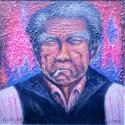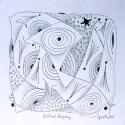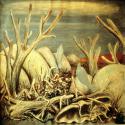Igarta, Venancio C.
V. C. Igarta never intended to be a painter; when he came to the United States from the Philippines on a student visa during the Depression, he had never studied art, indeed never seen a significant painting, at all. He followed the crops for four years before coming to New York, where he found the life no easier than in Hospital on Park Avenue; at this very posh private sanitarium, the meals were served on hand painted trays. Igarta painted one of these, making such an impression on the manager that she advised him to find a way to go to art school. A nurse advised him to get a job as a model for a life-drawing class; he created his first works as samples to get into the class as a student. The teacher was Charles Curran. Leon Krol was also teaching at this studio. Later he attended the Art Student League, then studied with William Palmer. However, he felt that the fine training he was receiving was only in tinting, and he needed more understanding of painting. He specifically wanted to learn about underpainting, about the way the masters manipulated paint, about how paints could be applied with only one or two brushes. After leaving the League, he began his real training, experimenting to achieve the colors of past masters; he bought his own pigments and linseed oil and ground his own paints. His curiosity about the old masters enabled him to learn about pigment and color. The floating color of Vermeer particularly intrigued him; he could see the technique of Hals or Rembrandt, but even after decades of studying color he has still not been able to determine what medium Vermeer used to create his transparent colors.
Through Igarta had a good reception when his paintings were first exhibited in group shows and he did have some reproduced for articles in Time and Fortune, he found little security as an artist in the Depression. He did help to organize and had work displayed at the Carnegie Foundation Building in the first show of Philippine art in New York. In a fateful moment he found work with the Color Aid company as a color mixer, where he developed, by eye – what he called: 'the thinking eye' – not by formula, the standardized color card packets still in use today. Igarta spent over three decades studying color relationships, durability, depth, and alteration at Color Aid. Igarta has called his color study project, which he has been enlarging over the last decades, the 'synopsis and syntax of color mutation'. These studies he applied to his paintings, whose force, like those of Josef Albers, who used Igarta's cards in his theories, is in the subtle manipulation of perception by proximity of color fields. Igarta feels that in his painting he is using Albers' simultaneous contrast while at the same time employing an overlay to create a transparent effect. Whereas Albers used no more than three or four colors in many of his greatest paintings, Igarta has used at least nine or ten colors.
Artist Biography
Gallery of Selected Works
Selected Documents
- Review "Igarta at the Metropolitan" by Armando Manalo in Philippine Times Journal, 1992
- V.C. Igarta Exhibition at The Philippine Center, New York, 1986
- Filipinas Magazine Article- Venancio C. Igarta, Colorist Par Excellence
- Monumental Figures - Memorial Catalogue
- Exhibition flyer for "Milieu III: COLOR in the ART of Natvar Bhavsar, Venancio C. Igarta, James Kuo, Ted Kurahara, Seong Moy", Asian American Arts Centre, 2000
- Exhibition press release for "Milieu III: COLOR in the ART of Natvar Bhavsar, Venancio C. Igarta, James Kuo, Ted Kurahara, Seong Moy", Asian American Arts Centre, 2000
- Exhibition brochure for "Ten Chinatown: Second Annual Open Studio Exhibition", Asian Arts Institute, 1986
- Exhibition postcard for "Kalooban", City Gallery 1985
Other Links
- WorldCat Identities Bibliography
- Filipino Online Art Gallery
- Venancio Igarta at Smithsonian American Art Museum
View artist folder list at Asian American Arts Centre











